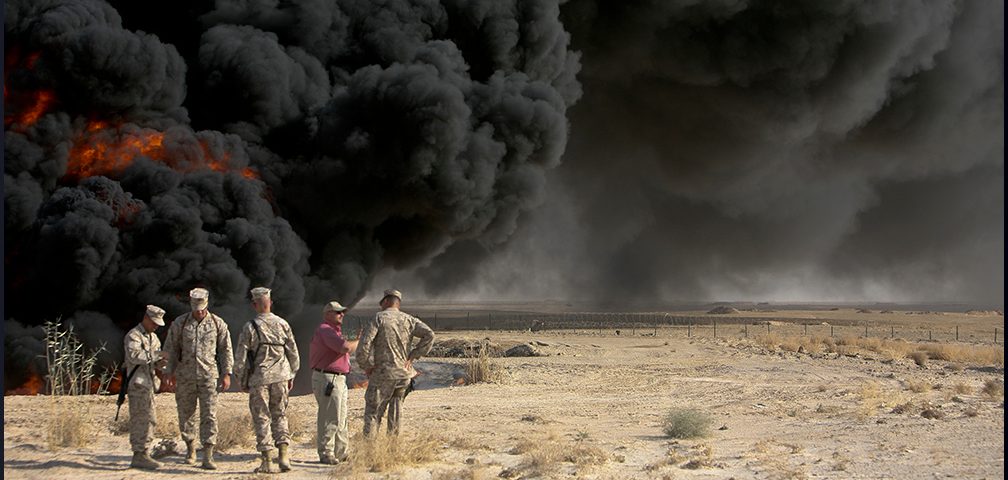
Is the Pentagon’s Climate Plan
Just ‘Military-grade Greenwash’?
Iffah Kitchlew / The Guardian
(March 10, 2022) — US military aims for net zero by 2050 but with a carbon footprint greater than some 140 countries critics say it needs radical change
The US military, an institution whose carbon footprint exceeds that of nearly 140 countries, says it wants to go green.
On 8 February, the US army released its climate strategy.
Among other tactics, the army aims for net-zero emissions by 2050, to electrify its combat and non-tactical vehicles, to power its bases with “carbon-free” electricity and to develop clean global supply chains.
Wars, like the one Russia has unleashed on Ukraine, are extreme polluters, and while the army’s plan would significantly reduce its greenhouse gas emissions, experts say it does not do nearly enough.
“The Department of Defense, the entity that is the US war machine, is the largest institutional contributor to global warming on planet Earth,” said David Vine, a professor of political anthropology at American University in Washington DC. “And the military does not acknowledge that.”
It does, at least, state that there is a need to reduce its “impact on the planet”. The Army Climate Strategy (ACS) admits, for example, that the US army’s nearly $740m yearly expenditure on electricity created 4.1m tons of greenhouse gases in 2020 – 1m tons more than the greenhouse gas emissions generated by Switzerland’s heat and electricity sector in 2017.
Although the ACS is reflective of the Pentagon’s newly serious stance on the climate crisis, which it has identified as a security threat, critics say the plan misses out on several crucial details.
It lacks accountability mechanisms, for one thing, said Doug Weir, research and policy director at the Conflict and Environment Observatory. “We need to ensure that scrutiny mechanisms are in place. Otherwise, it’s just military-grade greenwash,” he said.
The US military and army, for example, do not report their fuel usage to Congress, let alone itemize how much fuel was spent where, or on what war. Most US government accounting of US greenhouse gas emissions omit figures on how much the military contributes, even via a relatively easy-to-track measure like fuel consumption.
And consume fuel it does, in vast quantities. A 2019 report found that the Department of Defense is not only the largest consumer of energy in the US but is also the world’s largest institutional consumer of petroleum and, thus, the world’s largest institutional emitter of greenhouse gases.

Between 2001 and 2017 the DoD was responsible for emitting 1.2bn metric tons of greenhouse gases – equivalent to the annual emissions of 257m cars. This year it is expected to burn through 82.3m barrels of fuel, more than the total oil consumption of Finland.
The plan aims to reduce this number – but a more impactful way for the US military to address the scale and pace of its carbon footprint is to simply do less, said Neta Crawford, political scientist and co-director of Brown University’s Costs of War project.
She points to the fact that the US military has about 800 installations in 80 countries and another 740 bases on home soil, of which about 315 are army installations. Yet by its own admission, the Pentagon says the US army operates a third more bases than it needs – it calls this “excess basing capacity”.
“Far greater savings can be achieved by just closing a base rather than making a base that is unnecessary more energy efficient,” said Vine.

Even that kind of thinking would probably not be enough to reduce the armed forces’ greenhouse gas emissions as much as is needed, however. The military’s climate impact is “not just about the environmental footprint of the military itself, it’s also about the way the operations are conducted and the way wars are fought”, said Stefan Smith, coordinator at the UN Environment Programme’s disasters & conflicts sub-programme.
“War is, by its nature, destructive.”
Postwar reconstruction, for instance, uses up a vast amount of resources. The disposal of rubble and rebuilding from infrastructure destruction is a long, carbon-intensive process, according to Hassan Partow, a UNEP programme manager.
“The amount of trucking and emissions that would be required to dispose of this debris is like travelling from the Earth to the moon multiple times,” he said, referring to cleanups that were required in Iraq.
War also degrades land, altering and reducing its carbon sequestration capacity. “The land degradation legacy in Iraq shows that when you change the land and change the soils, that changes the amount of carbon it can store,” said Weir. To what extent is unclear, as it is rarely if ever studied. But soil erosion causes carbon loss, and desertification and degradation reduceland’s ability to hold carbon – all of which probably happened in Iraq, particularly in what was once marsh land.
“We know so little about” how much land is destroyed in this matter, Weir said. “No one’s really following or documenting it.” He thinks an even larger contributor to the climate crisis than the emissions caused by fighting is the environmental changes those conflicts create.
Of course, the fighting doesn’t help. Some of the first targets in conflict zones are oil infrastructure and power plants, said Partow. The US military has frequently targeted oil tankers in Syria and just last week Russian missiles attacked a number of oil and gas facilities in Ukraine. The resulting fires give rise to heavy emissions. “In the case of Iraq … people could not see the sun from all the emissions,” Partow added. US emissions rose dramaticallyfollowing the wars in Iraq and Afghanistan.
But even non-violent conflict triggers other emissions.
“When the United States acts to increase its presence in Asia and the Pacific, it alerts the Chinese to the American presence – and they respond by making more weapons which, in turn, produce more emissions,” said Crawford.
What can be done? Rather than only see the climate emergency as a security threat that needs to be trained for, Crawford suggests, the US military should help reduce the emergency itself, and the instability it will cause.
“A much better strategy than preparing for climate change-caused war is to prevent climate change-caused war,” said Crawford.
Federal and military budgeting priorities might also need to shift, according to Lindsay Koshgarian, programme director at the National Priorities Project. The White House is expected to request a military budget of more than $770bn for the next fiscal year.

An US Army M60-A3 tank.
“As long as we continue to put that amount of money into the military, we will not have the resources to deal with climate change,” said Koshgarian.
Even so, the ACS is considered an important document. “It does reflect a longstanding concern in the US military – that actually has been much more progressive and advanced than most of the rest of the US government – about global warming and climate change,” said Vine.
The move to electrify army vehicles, for example, is significant in the stimulus it gives to manufacturers to produce more electric vehicles and lower their costs in the rest of the country, said Crawford.
The Department of Defense will incorporate climate risks in its future strategies as well, including the expected national defense strategy, according to Richard Kidd, the deputy assistant secretary of defense for environment and energy resilience. A “comprehensive” climate mitigation and sustainability plan will be released in the fall, he said.
However, the concern remains that these strategies will only treat the symptoms, and only marginally. Although the ACS highlights the need to act “now” – it says so four times in the document – the targets are set over another 20 years.
To Koshgarian, plans like the ACS prompt a bigger question: can any military goals, such as sustained land dominance by any large military, America’s or otherwise, ever be sustainable?
“There’s no such thing as sustainable fast fashion. And there’s no such thing as sustainable global military hegemony.”

IPCC: Window to Avert Catastrophic Climate Change Is Quickly Closing
(April 6, 2022) — The Intergovernmental Panel on Climate Change on Monday released its latest report, which found that nations are falling short of their pledges to reduce greenhouse gas emissions in order to avert catastrophic climate change. While the technology exists to stay below 1.5 degrees Celsius (2.7 Fahrenheit) of average global temperature increase — the goal that virtually every nation agreed to in the 2015 Paris climate agreement and reaffirmed last year in the Glasgow Climate Pact — current policies put the world on a trajectory toward at least twice as much warming.
United Nations Secretary-General António Guterres called the report’s conclusion “damning.” The Working Group III report marks the end of the IPCC’s Sixth Assessment, with strong words for countries that have failed to act on climate change.
“The jury has reached a verdict. And it is damning,” Guterres said in a statement. “This report of the Intergovernmental Panel on Climate Change is a litany of broken climate promises. It is a file of shame, cataloging the empty pledges that put us firmly on track towards an unlivable world.”
The IPCC report included 278 authors from 65 countries reviewing over 18,000 scientific papers.
According to their findings, to meet the 1.5°C target, global greenhouse gas emissions have to start dropping in 2025 and go down 43% from current levels by 2030 — and 84% by 2050. Achieving that requires ambitious actions from large emitters such as the United States, the European Union and China in the next few years.
Waiting longer, the scientific consortium warned, will mean economic losses from the impacts of climate change such as drought, wildfires and sea level rise. Even limiting warming to 2°C (3.6°F) would require peaking emissions by 2025 and cutting them by roughly one-quarter by 2030.
Without a dramatic shift in policy, Guterres warned, “We are on a fast track to climate disaster: Major cities under water. Unprecedented heatwaves. Terrifying storms. Widespread water shortages. The extinction of a million species of plants and animals.”
The closest the IPCC came to sharing good news was revealing that the greenhouse gas emissions causing climate change are growing more slowly than in the past, thanks to increased energy efficiency and renewable energy technologies — particularly battery storage that is essential to widespread reliance on wind and solar energy.
Global emissions are at their highest level in history: 54% higher than in 1990, and 12% higher than they were in 2010. Emissions growth slowed from 2.1% per year in the 2000s to 1.3% annually in the 2010s.
The pathway to averting catastrophe is now clear and technologically feasible: Rapidly redesign the power sector to rely on renewable energy, switch transportation and heating to electric systems, and capture the carbon dioxide from the smokestack in the hardest-to-decarbonize sectors such as cement and steel production. For the situations where that is infeasible, such as air travel, carbon emissions can be offset with the emerging technology of actually removing carbon from the atmosphere.

A key problem is that energy utilities, car manufacturers, airlines, steel producers and other industries have no financial incentive to act without governments offering rewards or penalties to encourage participation.
“Does the technology exist so that you could pull this off? The answer is yeah, it does,” Jae Edmonds, chief scientist at the Pacific Northwest National Laboratory’s Joint Global Change Research Institute and a co-author of the IPCC report, told Yahoo News. “Do we have the policies and measures that have put us on track to get to net-zero [emissions] by a 2050 time frame? Not yet.”
Edmonds likened the current approach taken in Paris and Glasgow to reducing emissions as “the church model: We’re gonna fund this by passing the collection plate around and we’re gonna take up a collection of emissions mitigation and see where that gets us. And even if everyone were to complete their nationally determined contribution, … it doesn’t look like that’s going to be enough.”
Just operating the existing fossil fuel infrastructure — the oil and gas wells and pipelines, the coal mines and the coal- or gas-fired power plants for the rest of their natural lives — puts 1.5°C out of reach. And if every currently planned fossil fuel project is completed, it would only guarantee that the world warms more than 2°C. To stay below 1.5°C, the use of coal must be virtually eliminated by 2050, according to the IPCC, and oil use must decrease by at least 60% and gas by 45%.
The IPCC’s Fifth Assessment in 2014 predated two notable shifts that were central to the latest report: the increasingly universal agreement in the scientific community that 1.5°C is the threshold for triggering devastating and irreversible effects of climate change, and the increasing prevalence and awareness of methane emissions.
Methane is a long-overlooked but powerful greenhouse gas, and emissions of it are rapidly rising as natural gas displaces coal and demand for meat grows. (Methane is emitted when natural gas leaks instead of being burned, and it is a byproduct of the digestive process of farm animals.) The IPCC states that fast, deep cuts to methane emissions are essential to getting warming mitigation on target.

To stay below 1.5°C, carbon dioxide emissions must fall by 48% by 2030 and by 80% by 2040; methane emissions must fall by 34% by 2030 and 44% by 2040.
The IPCC is more bullish on wind and solar energy than on other low-carbon energy technology such as nuclear energy and hydropower, noting that costs have come down faster in the wind and solar industries. “From 2010–2019, there have been sustained decreases in the unit costs of solar energy (85%), wind energy (55%), and lithium-ion batteries (85%),” the IPCC report notes. (Lithium-ion batteries are needed for electric vehicles.)
Special presidential envoy for climate John Kerry hailed the IPCC report as a call to action. “The stakes are clear,” Kerry said in a statement. “Complacency will be met by irreversible and unthinkable impacts from climate change. Every country must move further and faster.
Faster means rapidly upscaling deployment of renewable energy. Faster means targeting methane emissions. Faster means reducing demand and focusing on efficiency. Faster means halting and reversing global deforestation. Faster means demanding more sustainable transit.
“The IPCC report is a reminder that mitigation is not about cost,” Kerry argued. “It is about investment — in our future, our children’s future, and our planet’s future.”
“This report tells us we are not doing enough to cut greenhouse gas emissions,” said United Nations Environment Program Executive Director Inger Andersen at a press conference on Monday morning.
“The solution has to be to kick-start the transition to renewable and cleaner sources of energy. Increased action must begin this year, not next year, this month, not next month, not tomorrow. Otherwise, we will continue, as the secretary-general warned, to sleepwalk into catastrophe.”
Posted in accordance with Title 17, Section 107, US Code, for noncommercial, educational purposes.